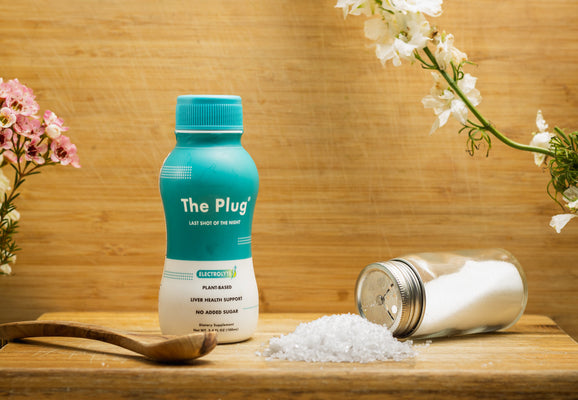blood pressure
Don’t Get Too Salty: Sodium’s Effect on the Liver
The Plug Drink

The Plug Team

Americans are addicted to salt. The average American consumes about 3,400mg per day when the recommended amount of sodium for adults is actually 2,300mg per day (1). This is not always because we are purposely adding salt to our food – an excess of sodium is often found in processed foods and restaurant meals. Most people know that consuming an excess amount of sodium can raise blood pressure and negatively affect their heart health, but what they do not realize is that a salt-heavy diet can damage their liver.
How Sodium Harms the Liver

Having a diet that includes a surplus of salty foods increases oxidative stress on the liver. This type of stress decreases the amount of protective antioxidants in the liver and can result in inflammation and fibrosis (2). Multiple studies have also shown that there is a higher risk of developing non-alcoholic fatty liver disease (NAFLD) with a high sodium diet compared to a low sodium diet. In human studies, sodium intake and NAFLD showed a clear relation: those with a high sodium diet were more likely to show NAFLD biomarkers and, therefore, were more at risk at developing NAFLD (3). Even if you are careful with consuming alcohol and fats, high amounts of sodium can still leave you at risk for developing liver disease.
How to Know If You’re Consuming Too Much Sodium

When salt builds up in your body, you retain fluid, which can then put strain on your heart, blood vessels, kidneys, and liver. This leads to negative side effects such as increased thirst, swollen hands or feet, headaches, and increased blood pressure (1). If you are experiencing these symptoms, it may be time to have a deeper look into your diet. Many of us have become accustomed to high amounts of salt in our foods because – simply – salt makes them taste better! Processed food companies and restaurants have been quick to catch on to this, which has resulted in an influx of products and meals with high sodium content.
How to Limit Your Salt Intake While Protecting Your Liver

If you have already been diagnosed with liver disease, limit your salt intake to less than 2,000mg of salt per day. If you have a healthy liver, aim for 2,300mg. The best way to do this is by eating more fresh, whole, unprocessed foods. If you do want to add more flavor, utilize ingredients other than salt like herbs, lemon, spices, and vinegars. Be sure to always read the nutrition label even when purchasing “low sodium” foods too! And if you do find yourself eating at a restaurant or consuming processed foods, pay attention to the portion sizes as to not overdo it (1).
You can also further protect your liver with The Plug Drink and The Plug Pills! With their all-natural antioxidant protection, you can help your liver recover from a high sodium diet or other toxins. By decreasing your overall sodium intake, maintaining a healthy diet, and adding The Plug to your routine, you can relieve any negative symptoms and prevent further damage to your liver. Don’t be salty – take care of your liver today!
Bibliography
1. McCallum K. What Happens If You Eat Too Much Salt? [Internet]. Houston Methodist Leading Medicine. 2022 Mar 17. Available from: https://www.houstonmethodist.org/blog/articles/2022/mar/what-happens-if-you-eat-too-much-salt/
2. Takashi F, Hashimoto Y, Kaji A, Sakai R, Kawate Y, Okamura T, et al. The Association of Salt Intake and Non-alcoholic Fatty Liver Disease in People With Type 2 Diabetes: A Cross-Sectional Study. Frontiers in Nutrition [Internet]. 2022 July 12;9. Available from: https://www.frontiersin.org/journals/nutrition/articles/10.3389/fnut.2022.943790/full
3. da Silva Ferreira G, Catanozi S, Passarelli M. Dietary Sodium and Nonalcoholic Fatty Liver Disease: A Systematic Review. Antioxidants (Basel) [Internet]. 2023 Feb 28;12(3):599. Available from: https://www.ncbi.nlm.nih.gov/pmc/articles/PMC10045331/
